My ‘trout’ river wet fly box
{{start}}
River trout fishing can be both challenging and fun. One element that can add to the fun is whilst having the right flies, don’t carry so many that your spoilt for choice or that the number of fly boxes that you carry is becoming to much to lug around. The “wets” that I carry when river fishing are all in this one fly box. This included both bead head and non bead head nymphs and spiders as well as one row of small woolly buggers. If you carry this fly box and my dry fly box you will have flies available that can be successfully applied to the vast majority of ‘trout’ rivers and streams in Australia and New Zealand.
{{end}}

{{+1}}Squirmy caddis{{-1}}
{{start}}
Somewhat of a fusion of a traditional caddis pupa emerger and a squirmy wormy this fly has earned a place in my fly box as a great middle or top dropper fly for both a loch style team and a river team.{{end}}

{{+1}}TBH Dross nymph variant{{-1}}
{{start}}
In 2018 I was introduced a fly called a Droz nymph that had skipped my attention even though it has been used for several seasons with great success in Tasmania, Victoria and even NSW. It's now one of the first river flies that I tie on.{{end}}
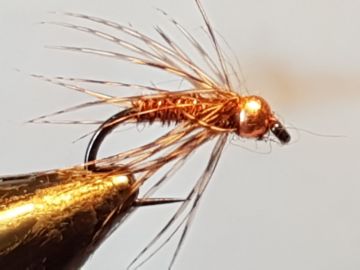
{{+1}}Pheasant tail and partridge TBH spider{{-1}}
{{start}}
If you were to suggest to a North Country (UK) fly fisher that there is such a thing as a tungsten bead head spider they would think your a rod section short of a fly rod.{{end}}
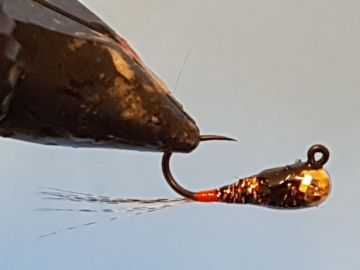
{{+1}}Perdigon (Spanish nymph) – gold micro glint{{-1}}
{{start}}
| A streamlined fast sinking fly that will anchor your team. |
Materials
| Hook | Head | Extra weight (optional) | Thread | Tail | Body | Thorax | Coating |
|---|---|---|---|---|---|---|---|
| Hanak 300BL #14 / #16 | 3.0mm / 2.5mm slotted faceted gold tungsten bead | 0.010 lead wire | Fl fire orange UTC UV thread | Coq de Leon Fibres | Brown Micro Glint | Black nail polish | UV Resin and then Varnish. |
Process
| A |
Adding extra weight to the fly.On this fly my preference is to keep the bead size down a little and to add extra weight to compensate for that. |

|
|---|
| B |
|

|
|---|
| C |
|
|
|---|
| D |
|

|
|---|
| E |
|

|
|---|
| F |
|

|
|---|
{{end}}
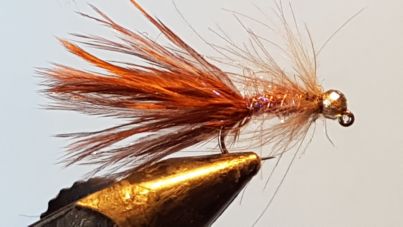
{{+1}}TBH / CDC river jig bugger – brown{{-1}}
{{start}}
In rivers they lend themselves to being swung down and across shallow water or to being swum down where the fish are holding in deeper pools. They also work well in a two fly Euro Nymph style team. In still water they are a great option fished alone at any depth to nervous fish and are an ideal middle dropper or point fly in a team of two or three buggers.{{end}}

{{+1}}Silver TBH CDC black/red MKII fuzzel bugger{{-1}}
{{start}}
MKII woolly buggers without any weight are amongst my favourite top dropper flies when loch style fly fishing in lakes and these smaller versions with a silver tungsten bead are up there amongst my favourite river flies.{{end}}
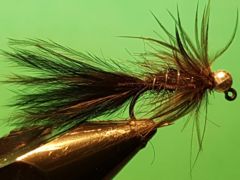
{{+1}}Silver TBH CDC black sparkle fuzzel bugger{{-1}}
{{start}}
This one of the 4 colours of TBH jig buggers that I carry in my river fly box. It's a great buggy looking fly that sink well and swims hook point up so less likely to get hooked up on the bottom othan flies that swim hook point down.{{end}}
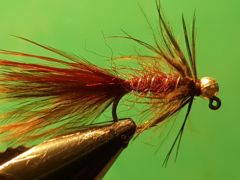
{{+1}}Gold TBH CDC brown fuzzel jig bugger{{-1}}
{{start}}
These are the only woolly bugger type flies that I now carry in my river fly box. They are a step up from my earlier version in that I have added a CDC under wing directly behind the front hackle which I have reduced down to just one full turn. I tie them in sizes #10 and #12 in just 4 colours.{{end}}
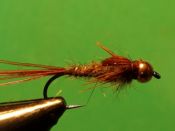
{{+1}}TBH “inch” nymph{{-1}}
{{start}}
This fly has it's origins based on my non bead-head inch nymph fly that I started tying over 20 years ago. For about 10 years now I have been tying this bead-head version in in black, dark olive, Adams colours, claret and brown. It's a great buggy looking fly and one of the on-going inclusions in my nymph fly box.{{end}}

{{+1}}Duracell jig nymph{{-1}}
{{start}}
I was attracted to this fly because it is made of two of my favourite fly tying materials UV Ice dubbing and CDC. It has looked like a winner since I first saw this fly and it has not let me down. Designed by, as I understand it, Craig McDonald it is a very popular fly in Europe and fast developing a following in Australia and New Zealand.{{end}}














